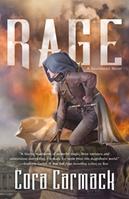
|
|
| Cora Carmack | |
There are more than 40 types of seizures, which sometimes go overlooked until they become so severe that your life is upended. I don't know exactly when mine started but it was clear something was wrong by the time edits came in for my YA fantasy novel Roar in 2016. The world of storm magic I'd created suddenly seemed too vast to understand. I kept a list of what to revise and what I'd written because I couldn't remember. I had difficulty completing sentences, I held my thesaurus like a lifejacket, I just couldn't... think.
 In October 2017, four months after Roar's release, and 20 months after I started seeking answers, I was diagnosed with epilepsy. What I thought was a panic attack was actually a nine-minute seizure in my temporal lobe--an area of the brain that deals with sensory processing, memory, language, emotional responses and more. Before I could approach the sequel to Roar, I endured nine months of failed medications, three types of seizures and months of adjusting to medications. When I came back to the series, I looked at my heroine and her storm-filled world and was surprised to see echoes of my epilepsy in her story. Neurologists have described seizures as electrical "storms in the brain"; the intrusive bursts of emotion Aurora experiences during storms were reminiscent of my temporal lobe seizures. We both grappled with feeling like our bodies had turned against us.
In October 2017, four months after Roar's release, and 20 months after I started seeking answers, I was diagnosed with epilepsy. What I thought was a panic attack was actually a nine-minute seizure in my temporal lobe--an area of the brain that deals with sensory processing, memory, language, emotional responses and more. Before I could approach the sequel to Roar, I endured nine months of failed medications, three types of seizures and months of adjusting to medications. When I came back to the series, I looked at my heroine and her storm-filled world and was surprised to see echoes of my epilepsy in her story. Neurologists have described seizures as electrical "storms in the brain"; the intrusive bursts of emotion Aurora experiences during storms were reminiscent of my temporal lobe seizures. We both grappled with feeling like our bodies had turned against us.
Sometimes I felt like I'd written Roar for future-me, for hurting-me, healing-me. Like my princess born without magic, I wondered if I could meet the expectations placed on me. Could I still write with a healing, heavily medicated mind? Slowly, with the support of loved ones, therapy and my publisher, I found a way through. As one of my characters said before I knew I needed it, "Sometimes you must make answers when there are none." --Cora Carmack (Rage, book two in the Stormheart series, is available now from Tor Teen)

